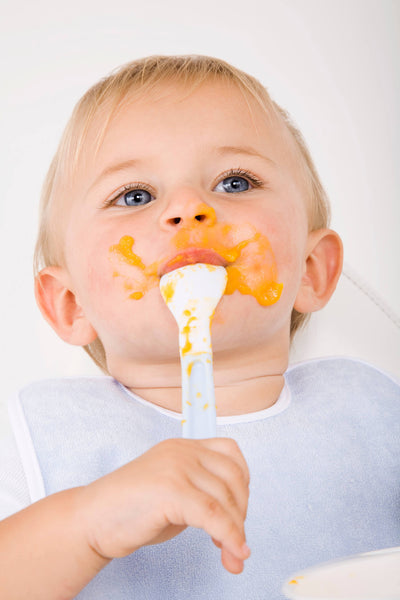
How to encourage your baby to self-feed at 10-12 months
Share
Your little one will be becoming an experienced eater of different food groups by the time they are almost one year old.
Now that they can sit comfortably in their high chair, they will be using their hands a lot more to hold small food items between their fingers and thumb.
You will also find that your baby will reach out for the spoon when you’re feeding them. Encouraging self-feeding is a great way to teach them independent eating skills.
Self-feeding with cutlery
When you start encouraging your baby to self-feed, one of the best ways is to use sticky foods like porridge, mashed vegetables or pureed fruit. As the food clings to the spoon, it makes it much easier for your baby to get a mouthful before it all slides off.
You can also fill the spoon and then offer it to your baby, rather than them trying to scoop up the food, which can be a tricky skill and can discourage some babies from self-feeding.
If you find that your little one is not eating enough when self-feeding, you can try using two spoons, one for them to hold and one that you can fill with food while they are trying to eat by themselves from the bowl.

A chunky spoon with an easy-grip handle will make it easier for your baby to feed themselves. Even if your baby doesn't want to feed themselves, giving them a spoon to play with and chew will mean they associate cutlery with meal times.
Use a bowl with a sucker on the bottom that will stick to the high chair table. This makes it much easier for your baby to get their food on their spoon without having to hold onto the bowl as well. This also helps to stop them from throwing the bowl when they have had enough.
Finger foods for self-feeding
At 10-12 months, you can start introducing your baby to a wider variety of flavours and textures. It is recommended that you cook vegetables, such as carrots or green beans, which makes them softer and easier the manage.
Even bitter vegetables such as broccoli and kale are a good choice as you are exposing your baby to different tastes. When giving you baby fruit, make sure that you have washed it thoroughly and removed any pips, stones or tough skin.
Meat, fish, eggs, beans and pulses are suitable from around six months. As well as giving your baby protein, these foods contain other valuable nutrients, such as iron and zinc, which are essential for babies.
Crunchy foods like breadsticks, toast, rice cakes, and cereals are also great foods for your baby and easy to hold onto. As your baby gets better at feeding themself, you may be able to introduce them to a daily finger food meal.

Using a cup
During meal times, offer your baby sips of water from an open cup or a free-flow cup. Learning to sip water is a new skill and better (than sucking from a bottle) for your baby’s growing teeth.
There are many options to choose from with baby-friendly features, and you may need to try different kinds before you find one that your baby can drink from easily. As they develop more confidence, they will help themselves to sips of water as and when they are thirsty.

Role modelling
You can support your little one to feed themselves by eating together as a family as they have a chance to see others using cutlery and enjoying mealtime. By eating a variety of foods, your little one will develop healthy food habits and will be encouraged to try these foods too.
